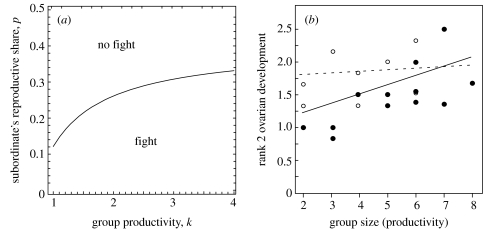Figure 1.
(a) Zones for which the challenger's payoff is positive (‘fight’) or negative (‘no fight’), as a function of group productivity and the subordinate's fraction of reproduction. In the example shown, the dominant and the subordinate are full sisters (r=0.75), of equal strength (f=0.5) and the cost of fighting is c=0.05 fitness units. (b) Results of the dominant removal–reintroduction experiment. Mean ovarian development of rank 2 subordinates is plotted as a function of group size, which is an index of group productivity. Solid circles, rank 2 individuals that engaged in an escalated contest with the returning dominant; open circles, rank 2s that immediately submitted to the returning dominant. The significant least-squares regression for all rank 2s is shown (solid line). In addition, the non-significant least-squares regression of dominant ovarian development is plotted against group size (dashed line). Both the level of subordinate ovarian development and group size had significant effects on the probability of an escalated contest.

